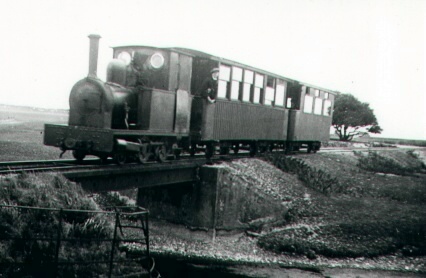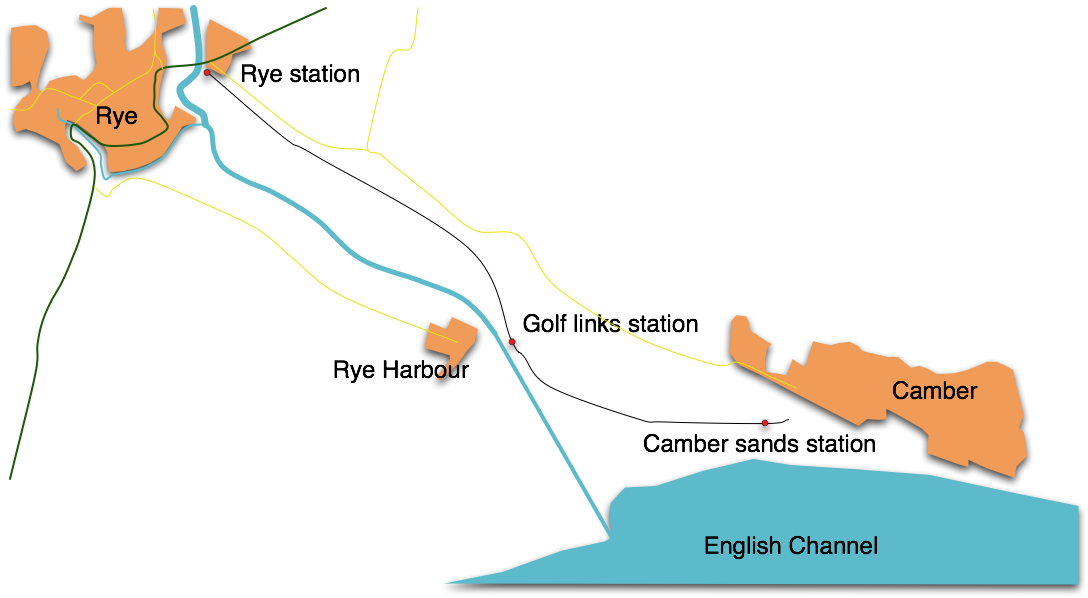Rye And Camber Tramway on:
[Wikipedia]
[Google]
[Amazon]





 The
The
Colonel Stephens Museum R&C page
A Talk on the Camber Tram by Ken Clark
{{DEFAULTSORT:Rye And Camber Tramway History of East Sussex Rail transport in East Sussex 3 ft gauge railways in England Rother District Railway lines opened in 1895 Closed railway lines in South East England Railway lines closed in 1939 HF Stephens





 The
The Rye
Rye (''Secale cereale'') is a grass grown extensively as a grain, a cover crop and a forage crop. It is a member of the wheat tribe (Triticeae) and is closely related to both wheat (''Triticum'') and barley (genus ''Hordeum''). Rye grain is u ...
and Camber Tramway was an English railway in East Sussex
East Sussex is a ceremonial and non-metropolitan county in South East England on the English Channel coast. It is bordered by Kent to the north and east, West Sussex to the west, and Surrey to the north-west. The largest settlement in East Su ...
. It was of narrow gauge, relatively unusual amongst British narrow gauge railways. It operated from 1895 until 1939, connecting Rye
Rye (''Secale cereale'') is a grass grown extensively as a grain, a cover crop and a forage crop. It is a member of the wheat tribe (Triticeae) and is closely related to both wheat (''Triticum'') and barley (genus ''Hordeum''). Rye grain is u ...
to the coast. It was about in length, and had three stations - Rye, Golf Links and Camber Sands. It operated mainly to transport golfers to the golf links and holidaymakers to the coastal dunes.
History
The railway was constructed between January and July 1895 and ran entirely on private land. It was the first designed by consulting engineer Holman F. Stephens, who went on to build and run small railways all over the Country. The line was built to convey golfers to the Rye Golf Club and ran from Rye (R&CT) station to the golf club. In 1908 the first extension to Camber Sands station was opened and the intermediate station renamed "Golf Links". Camber Sands terminal was moved to a more accessible site and a tea hut was opened at the end of summer 1938, but this only used for a few months as the war intervened the next year. Although initially quite successful, increasing competition from automobile and bus transport eventually caused the tramway to enter a gradual economic decline, as was the case with many small railways. Passenger service was ended at the outbreak of World War II but it was extensively used by the Government to convey parts for the P.L.U.T.O. (Pipe Line Under The Ocean) project for which a special siding leading to a new pier near Golf Links Station was constructed by Canadian troops. The line was in such a run-down a condition by the end of the war that it was deemed irrecoverable and was sold for scrap in 1947. The Rye & Camber Tramways Co. Ltd was liquidated in February 1949.Remains
A number of relics, including the frame and bogies of one of the carriages, can be seen at the Colonel Stephens Museum at Tenterden. Golf Links station building survives virtually intact. Some track is embedded in concrete near the station as the trackbed was used as a roadway during wartime. Most of the route is a footpath, although a short section has been destroyed by gravel workings. The line plays a prominent part in several novels by Rye residentE.F. Benson
Edward Frederic Benson (24 July 1867 – 29 February 1940) was an English novelist, biographer, memoirist, archaeologist and short story writer.
Early life
E.F. Benson was born at Wellington College in Berkshire, the fifth child of the headma ...
.
Rolling stock
Locomotives
There were two small Bagnallsteam locomotive
A steam locomotive is a locomotive that provides the force to move itself and other vehicles by means of the expansion of steam. It is fuelled by burning combustible material (usually coal, oil or, rarely, wood) to heat water in the locomot ...
s, "Camber" and "Victoria", but in later years a small petrol locomotive was used exclusively.
Carriages
The tramway had two enclosed carriages, one built by Bagnall and the other by The Rother Iron Works, Rye. Two four-wheel wagons were also fitted with seats for passengers and several locally-built four-wheel wagons were used to convey sand from the beach for local builders. Several temporary sidings were constructed at the Camber end for this purpose, where the dug-out dunes can still be seen.See also
* British narrow gauge railwaysReferences
Sources
* * * *Further reading
* *External links
Colonel Stephens Museum R&C page
A Talk on the Camber Tram by Ken Clark
{{DEFAULTSORT:Rye And Camber Tramway History of East Sussex Rail transport in East Sussex 3 ft gauge railways in England Rother District Railway lines opened in 1895 Closed railway lines in South East England Railway lines closed in 1939 HF Stephens